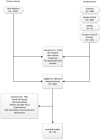Provider-to-provider electronic communication in the era of meaningful use: a review of the evidence
- PMID: 24101544
- PMCID: PMC4030393
- DOI: 10.1002/jhm.2082
Provider-to-provider electronic communication in the era of meaningful use: a review of the evidence
Abstract
Background: Electronic communication between providers occurs daily in clinical practice but has not been well studied.
Purpose: To assess the impact of provider-to-provider electronic communication tools on communication and healthcare outcomes through literature review.
Data sources: Ovid MEDLINE, PubMed, Google Scholar, Cumulative Index to Nursing and Allied Health Literature, and Academic Search Premier.
Study selection: Publication in English-language peer-reviewed journals. Studies provided quantitative provider-to-provider communication data, provider satisfaction statistics, or electronic health record (EHR) communication data.
Data extraction: Literature review.
Data synthesis: Two reviewers conducted the title review to determine eligible studies from initial search results. Three reviewers independently reviewed titles, abstracts, and full text (where appropriate) against inclusion and exclusion criteria.
Limitations: Small number of eligible studies; few described trial design (20%). Homogeneous provider type (physicians). English-only studies.
Conclusions: Of 25 included studies, all focused on physicians; most were observational (68%). Most (60%) described electronic specialist referral tools. Although overall use has been measured, there were no studies of the effectiveness of intra-EHR messaging. Literature describing the effectiveness of provider-to-provider electronic communications is sparse and narrow in scope. Complex care, such as that envisioned for the Patient Centered Medical Home, necessitates further research.
© 2013 Society of Hospital Medicine.
Conflict of interest statement
Similar articles
-
Beyond the black stump: rapid reviews of health research issues affecting regional, rural and remote Australia.Med J Aust. 2020 Dec;213 Suppl 11:S3-S32.e1. doi: 10.5694/mja2.50881. Med J Aust. 2020. PMID: 33314144
-
Secure Provider-to-Provider Communication With Electronic Health Record Messaging: An Educational Outreach Study.J Healthc Qual. 2018 Sep/Oct;40(5):283-291. doi: 10.1097/JHQ.0000000000000115. J Healthc Qual. 2018. PMID: 29280777 Free PMC article.
-
Patient Centeredness in Electronic Communication: Evaluation of Patient-to-Health Care Team Secure Messaging.J Med Internet Res. 2018 Mar 8;20(3):e82. doi: 10.2196/jmir.8801. J Med Internet Res. 2018. PMID: 29519774 Free PMC article.
-
Web-Based Tools for Text-Based Patient-Provider Communication in Chronic Conditions: Scoping Review.J Med Internet Res. 2017 Oct 27;19(10):e366. doi: 10.2196/jmir.7987. J Med Internet Res. 2017. PMID: 29079552 Free PMC article.
-
Electronic Medical Record-Based Electronic Messaging Among Patients with Breast Cancer: A Systematic Review.Appl Clin Inform. 2023 Jan;14(1):134-143. doi: 10.1055/a-2004-6669. Epub 2022 Dec 29. Appl Clin Inform. 2023. PMID: 36581054 Free PMC article.
Cited by
-
Clinician Perceptions on the Use of Free-Text Communication Orders.Appl Clin Inform. 2021 May;12(3):484-494. doi: 10.1055/s-0041-1731002. Epub 2021 Jun 2. Appl Clin Inform. 2021. PMID: 34077971 Free PMC article.
-
Digitally-mediated coordination in healthcare: the effects of teleconsultation on doctor-to-doctor relational coordination.BMC Health Serv Res. 2024 Feb 28;24(1):258. doi: 10.1186/s12913-024-10726-5. BMC Health Serv Res. 2024. PMID: 38419009 Free PMC article.
-
Using telephony data to facilitate discovery of clinical workflows.Appl Clin Inform. 2017 Apr 19;8(2):381-395. doi: 10.4338/ACI-2016-11-RA-0191. Appl Clin Inform. 2017. PMID: 28421225 Free PMC article.
-
A Novel Approach to Establish and Enhance Event Reporting Systems Among Resident Physicians.AEM Educ Train. 2020 Nov 22;5(3):e10554. doi: 10.1002/aet2.10554. eCollection 2021 Jul. AEM Educ Train. 2020. PMID: 34124502 Free PMC article.
-
mHealth for image-based diagnostics of acute burns in resource-poor settings: studies on the role of experts and the accuracy of their assessments.Glob Health Action. 2020 Dec 31;13(1):1802951. doi: 10.1080/16549716.2020.1802951. Glob Health Action. 2020. PMID: 32814518 Free PMC article.
References
-
- Foy R, Hempel S, Rubenstein L, Suttorp M, Seelig M, Shanman R, et al. Meta-analysis: Effect of Interactive Communication Between Collaborating Primary Care Physicians and Specialists. Ann Intern Med. 2010;152(4):247–58. Epub 2010/02/17. - PubMed
Publication types
MeSH terms
Grants and funding
LinkOut - more resources
Full Text Sources
Other Literature Sources
Medical


